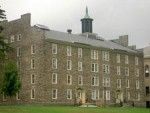Know Room?

In the fall of 1950, there was a sizeable thunderstorm and a lightning bolt hit the weathervane on the roof of West Hall, causing a fire that made most of the building uninhabitable for the rest of the school year. Displaced students had to cram into other residence halls and move into nearby hotels. That said, although the 2007 first-years moved in on a ominously overcast day, the materials the building are furbished with today are much less flammable and fire-fighting equipment is much more advanced, so it would not take eight hours to put out an unlikely fire as it did in 1950.
Colgate’s first-year residence halls each have similar stories to tell.
The night of the fire in West there were three first-year halls and today there are six: Andrews, Curtis, East, Gate House, Stillman and West. Unlike past students, who were asked to help build the school residence halls, the class of 2011 will not be asked to contribute backbreaking labor to find a place to live — merely a few pieces of Residential Life paperwork.
Built by those students in 1827, West Hall is not only Colgate’s oldest residence hall, but the first structure on campus created for “college purposes,” originally encompassing a museum and chapel. Colgate ran into some trouble when it could no longer afford the construction and had to postpone the completion of the building until Nicholas Brown, Jr. of Providence, Rhode Island – the same Brown of Brown University – stepped in and donate enough money to complete the construction. It was converted into a residence hall in 1910, when it housed no more than 100 male students. Today the building is single-sex by floor.
Today, Colgate students refer to the building as West Hall, but it was originally titled “Western Edifice.”
“West was a little more low key than the other dorms, but it seemed everyone really got along,” sophomore Matt Matsumura said of his experience there last year.
Built in1834, East is the second oldest residence hall on campus. On the first floor, there used to be a parents lounge, where students’ family members could stay while they were visiting. Although this lounge no longer exists and parents may not stay overnight in any of the first-year residence halls, the sober atmosphere of home is preserved by the substance-free environment. This may not be for everyone, but many students enjoy the close-knit environment that East provides as well as its proximity to most of the academic buildings. East’s basement is home to the Women’s Studies center, and its first floor houses the Center for Outreach and Volunteer Education (COVE), making it a convenient location for the CAn-dOO living/learning community.
Andrews Hall opened its doors in 1922 and is named after Professor Newton Lloyd Andrews. It is stereotypically known as a party dorm with large rooms. Floors two through four are co-ed by room, but the first floor is split in half and each half in single-sex; one accesses each side from a different door. The rooms are all three, four or five-person suites.
“I made some great friends in [Andrews] during my first year. My suitemates and I got really close,” senior Fernanda Carvalho, who is now a Resident Advisor (RA) in Curtis, said.
In 1928, Colgate completed construction of Stillman Hall. The building was commisioned and named in honor of Thomas Edgar Stillman, a graduate of the class of 1859. The building is divided into East, Center and West, which are each accessed from different doors, though students can travel between sections through the basement or the attic. Stillman is mostly made up of suites, although there are some doubles and singles. Last year, Stillman held the reputation as the biggest first-year party dorm and, consequently, its students paid the price through high damage fees.
Built in 1995, Curtis is the second-newest residence hall. It offers spacious community areas, it is close to Curtiss E. Frank Dinning Hall and is the only first-year residence hall with elevators. The flip side is that the rooms are small and it is relatively far from most of the academic buildings. Located in Curtis is the Outdoor Connections program, which allows first-year students to participate more actively in Outdoor Education.
Next to the O’Connor Campus Center and up the hill from the African, Latin, Asian and Native American Cultural Center stands Gate House, the newest first-year residence hall on campus. Only two stories high, Gate House does not follow the pristine stone wall theme that most other Colgate buildings do, but residents seem enthusiastic about their placement nonetheless. The rooms are extremely spacious, since they were orginally designed to be triples but are now used as doubles. Gate House is also home to Leadership Options For Tomorrow (LOFT) students. This special living community, combined with the building’s distance from other first-year residence halls provides a strong sense of community among Gate House students.
“LOFT builds strong connections between its residents more than others,” sophomore Tim Allen said.
As first-years, one of the biggest concerns students face when confronted with college life is residence hall living. Some students are excited about living among their peers and pleased to know that entertainment can be found at all hours just down the hall. Others are more skeptical about being forced to leave the familiarity and comfort of home. Either way, the diversity among the six first-year residence halls is extensive, each with its own history, style and atmosphere.






